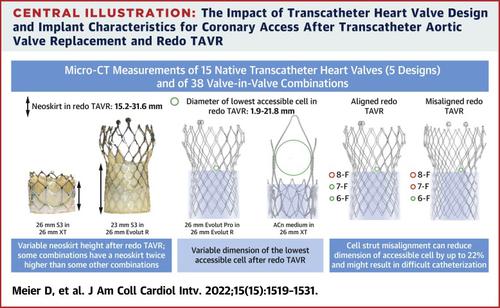JACC: Cardiovascular Interventions ( IF 11.3 ) Pub Date : 2022-07-13 , DOI: 10.1016/j.jcin.2022.05.005 David Meier 1 , Mariama Akodad 1 , Uri Landes 2 , Aaron M Barlow 3 , Andrew G Chatfield 1 , Althea Lai 4 , Georgios Tzimas 3 , Gilbert H L Tang 5 , Thomas Puehler 6 , Georg Lutter 6 , Jonathon A Leipsic 3 , Lars Søndergaard 7 , David A Wood 8 , John G Webb 8 , Stephanie L Sellers 9 , Janarthanan Sathananthan 9

|
Background
The implications and potential challenges of coronary access after redo transcatheter aortic valve replacement (TAVR) are unknown.
Objectives
The authors sought to evaluate the impact of different transcatheter heart valve (THV) designs, neoskirt height, implant technique, and cell misalignment on coronary access after redo TAVR.
Methods
Different THV designs (Sapien 3 [Edwards Lifesciences LLC], Evolut Pro [Medtronic], ACURATE neo [Boston Scientific Corporation], and Portico [Abbott Structural Heart]) and sizes were implanted inside Sapien XT (Edwards Lifesciences LLC) and Evolut R (Medtronic) THVs, which were modeled as the “failed” THVs, at different implant depths. Valve combinations underwent micro–computed tomography to determine the neoskirt height and dimensions of the lowest accessible cell for potential coronary access. This was compared with dimensions of 6-F/7-F/8-F coronary guiding catheters.
Results
Redo TAVR combinations resulted in a wide range of neoskirt heights (15.4-31.6 mm) and a variable diameter of the lowest accessible cell (1.9-21.8 mm). An ACURATE neo implanted in a Sapien XT resulted in the largest accessible cells, whereas a Portico implanted in a Sapien XT resulted in the lowest neoskirt heights. The smallest accessible cell was observed in the Evolut Pro–in–Evolut R configuration with higher neoskirt heights. Redo TAVR in a tall frame valve with supra-annular leaflets caused a taller neoskirt height. In Evolut-in-Evolut combinations, misalignment of the cells of the 2 THVs reduced the cell area by 30% to 50% compared with an aligned configuration.
Conclusions
This study demonstrates that different redo TAVR combinations are not equivalent in terms of future coronary access. Redo TAVR using a tall frame valve in a failed tall frame valve and misaligned cells may lead to potentially challenging coronary access.
中文翻译:

重做 TAVR 后的冠状动脉通路
背景
重做经导管主动脉瓣置换术 (TAVR) 后冠状动脉通路的影响和潜在挑战尚不清楚。
目标
作者试图评估不同经导管心脏瓣膜 (THV) 设计、新裙高度、植入技术和细胞错位对再次 TAVR 后冠状动脉通路的影响。
方法
在 Sapien XT (Edwards Lifesciences LLC) 和 Evolut R (美敦力 (Medtronic))THV,它们被建模为不同植入深度的“失败”THV。瓣膜组合进行了显微计算机断层扫描,以确定新裙高度和潜在冠状动脉通路的最低可及单元的尺寸。这与 6-F/7-F/8-F 冠状动脉引导导管的尺寸进行了比较。
结果
重做 TAVR 组合导致宽范围的新裙高度(15.4-31.6 毫米)和最低可及细胞的可变直径(1.9-21.8 毫米)。植入 Sapien XT 中的 ACURATE neo 产生了最大的可触及单元,而植入 Sapien XT 中的 Portico 产生了最低的新裙高度。在 Evolut Pro-in-Evolut R 配置中观察到最小的可接近电池,具有更高的新裙高度。在具有超环状小叶的高框架瓣膜中重做 TAVR 会导致更高的新裙高度。在 Evolut-in-Evolut 组合中,与对齐配置相比,2 个 THV 的电池未对齐将电池面积减少了 30% 至 50%。
结论
这项研究表明,不同的重做 TAVR 组合在未来冠状动脉通路方面并不相同。在失败的高架瓣膜和错位的细胞中使用高架瓣膜重做 TAVR 可能导致潜在的具有挑战性的冠状动脉通路。


























 京公网安备 11010802027423号
京公网安备 11010802027423号